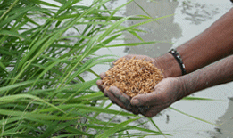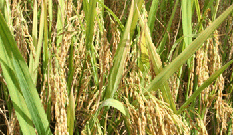System of Rice Intensification (SRI)
 Rice is the main source of directly consumed calories for about half the world’s population and 90% is produced and consumed in Asia. It is estimated that 24-30% of the world’s accessible freshwater resources (rivers, lakes and aquifers) are used to irrigate rice (IWMI 2007). By 2025, 15–20 million of the world’s 79 million hectares of irrigated rice lowlands, which provide three-quarters of the world’s rice supply, are expected to suffer some degree of water scarcity (IWMI 2007). India has the world’s largest rice cultivated area and already faces a major water crisis. Demand for a water-intensive crop such as rice is expected to increase by 38% by 2040, deepening the existing water crisis.
Rice is the main source of directly consumed calories for about half the world’s population and 90% is produced and consumed in Asia. It is estimated that 24-30% of the world’s accessible freshwater resources (rivers, lakes and aquifers) are used to irrigate rice (IWMI 2007). By 2025, 15–20 million of the world’s 79 million hectares of irrigated rice lowlands, which provide three-quarters of the world’s rice supply, are expected to suffer some degree of water scarcity (IWMI 2007). India has the world’s largest rice cultivated area and already faces a major water crisis. Demand for a water-intensive crop such as rice is expected to increase by 38% by 2040, deepening the existing water crisis.
 The System of Rice Intensification (SRI) is a set of principles and practices for increasing the productivity of irrigated rice by changing the current conventional management of plants, soil, water and nutrients. The practices include developing nutrient-rich and un-flooded nurseries instead of flooded ones; ensuring wider spacing between rice seedlings; applications of composts or manure rather than synthetic fertilizers; and managing water carefully to avoid saturation of the rice plant’s roots. These practices contribute to both more fertile soil and healthier plants supported by greater root growth and the nurturing of soil microbial abundance and diversity.
The System of Rice Intensification (SRI) is a set of principles and practices for increasing the productivity of irrigated rice by changing the current conventional management of plants, soil, water and nutrients. The practices include developing nutrient-rich and un-flooded nurseries instead of flooded ones; ensuring wider spacing between rice seedlings; applications of composts or manure rather than synthetic fertilizers; and managing water carefully to avoid saturation of the rice plant’s roots. These practices contribute to both more fertile soil and healthier plants supported by greater root growth and the nurturing of soil microbial abundance and diversity.
 SRI methods help increase yields by over 30%, while using 40% less water than conventional methods. The method was initially developed in the 1980s in Madagascar and has been validated in 43 countries. SRI practices and concepts have also been successfully adapted to upland rice and to other crops such as wheat, finger millet, and sugarcane.
SRI methods help increase yields by over 30%, while using 40% less water than conventional methods. The method was initially developed in the 1980s in Madagascar and has been validated in 43 countries. SRI practices and concepts have also been successfully adapted to upland rice and to other crops such as wheat, finger millet, and sugarcane.
 Although the benefits of SRI have been amply demonstrated around the world, the potential to achieve these benefits through large-scale implementation of the methods has yet to be tapped. The report More Rice with Less Water recommends that major rice-producing countries, such as India, China and Indonesia, convert at least 25% of their current rice cultivation to SRI methods by 2025. This would not only dramatically reduce the use of water for rice production but also improve global food security.
Although the benefits of SRI have been amply demonstrated around the world, the potential to achieve these benefits through large-scale implementation of the methods has yet to be tapped. The report More Rice with Less Water recommends that major rice-producing countries, such as India, China and Indonesia, convert at least 25% of their current rice cultivation to SRI methods by 2025. This would not only dramatically reduce the use of water for rice production but also improve global food security.
SRI Principles
Rice plants Seedlings are transplanted:- Very young - usually just 8-12 days old, with just two small leaves
- Carefully and quickly to have minimum trauma to the roots
- Singly, only one per hill instead of 3-4 together to avoid root competition
- Widely spaced to encourage greater root and canopy growth
- In a square grid pattern, 25x25 cm or wider in good quality soil
SRI Benefits
SRI methods increase the productivity of:- Water - since yields can double or more with only half as much water, the productivity of water is greatly increased - this is especially important in countries or places where water is becoming scarcer.
- Land - yields as indicated above can average about 8 t/ha once the methods are used correctly, and can be twice that or more when they are used with precision and skill.
- Labor - SRI can require more labor - about 26% in one Madagascar evaluation, 11% in a Sri Lankan survey - but depending on the cost of labor, the value of increased production increases the returns to labor by at least 50% and often several hundred percent. Once the methods have been mastered, the labor requirements for SRI decline. Also, implements are being developed that save labor. Due to smaller seedlings and fewer seedlings to transplant the drudgery of women’s work is dramatically reduced.
Other benefits include
- SRI is environmentally-friendly. Reduced demand for water frees up water for other uses; soil that is not kept saturated has greater biodiversity.
- SRI is accessible for farmers who have small landholdings and need to get the highest yields possible from their available land.
- When SRI paddy is milled, the outturn if often higher, as there are fewer unfilled grains (less chaff) and fewer broken grains (because they resist shattering).
- Farmers are finding that SRI methods often, though not always, reduce the time required for grain maturation.
- By reducing the application of agrochemicals in rice production, the resulting grain has little or no chemical residues.
For more information on SRI implementation visit: www.sri-india.net, www.ciifad.cornell.edu/sri and contact: info@agsri.com

